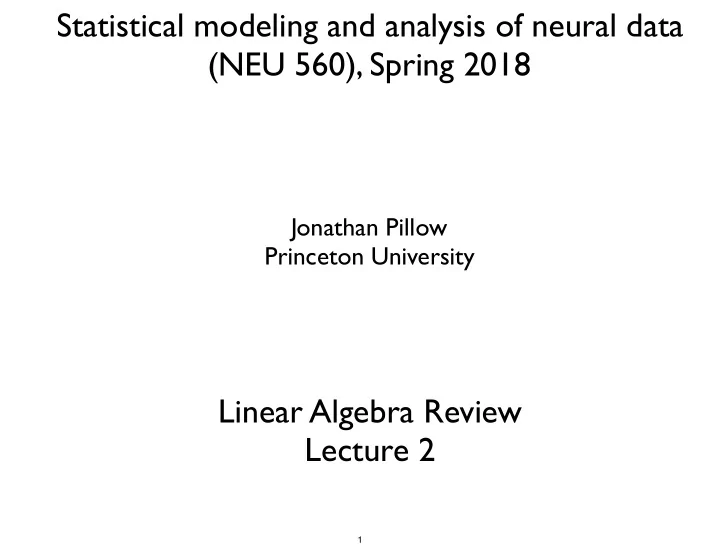

Statistical modeling and analysis of neural data (NEU 560), Spring 2018 Jonathan Pillow Princeton University Linear Algebra Review Lecture 2 1
Linear algebra “Linear algebra has become as basic and as applicable as calculus, and fortunately it is easier.” - Glibert Strang, Linear algebra and its applications 2
vectors v v 3 v 1 v v 2 v 2 v 2 � v = . . v v . 1 1 v N v N 1 v 2 v 3
column vector in python v 1 v 2 � v = # make a 3-component column vector . . v = np.array([[3], [1], [-7]]) . v N transpose # transpose row vector v.T # create row vector directly v = np.array([[3,1,-7]]) # row vector # or v = np.array([3,1,-7]) # 1D vector 4
addition of vectors v translated w w v � v 5
scalar multiplication v 2 v v 6
vector norm (“L2 norm”) • vector length in Euclidean space v v 2 In 2-D: In n -D: v 1 7
vector norm (“L2 norm”) in python # make a vector v = np.array([1, 7, 3, 0, 1]) # many equivalent ways to compute norm np.linalg.norm(v) # built-in function np.sqrt(np.dot(v,v)) # sqrt of dot product np.sqrt(v.T @ v) # sqrt of v-tranpose times v np.sqrt(sum(v * v)) # sqrt of sum of elementwise product np.sqrt(sum(v ** 2)) # sqrt of v elementwise-squared # note use of @ and * and ** # @ - gives matrix multiply # * - gives elementwise multiply # ** - gives exponentiation (“raising to a power”) 8
unit vector • vector such that v v 2 • in 2 dimensions v 1 unit circle 9
unit vector • vector such that • in n dimensions • sits on the surface of an n -dimensional hypersphere 10
unit vector • vector such that • make any vector into a unit vector via 11
inner product (aka “dot product”) • produces a scalar from two vectors w φ vw v b � b . v . w v . w w 12
linear projection • intuitively, dropping a vector down onto a linear surface at a right angle • if u is a unit vector, length of projection is v ^ u ^ ( . ) v u ^ u • for non-unit vector, length of projection = 13
linear projection • intuitively, dropping a vector down onto a linear surface at a right angle • if u is a unit vector, length of projection is v ^ u ^ ( . ) v u ^ u } component of v in direction of u • for non-unit vector, length of projection = 14
orthogonality • two vectors are orthogonal (or “perpendicular”) if their dot product is zero: v component of v orthogonal to u ^ u ^ ( . ) v u ^ u } component of v in direction of u 15
linear combination • scaling and summing applied to a group of vectors v v 1 3 • a group of vectors is linearly v dependent if one can be written as 2 a linear combination of the others • otherwise, linearly independent 16
matrices n × m matrix can think of it as: n row vectors m column vectors r 1 … … c 1 c m or r n 17
matrix multiplication One perspective: dot product with each row: 18
matrix multiplication Other perspective: linear combination of columns v 1 u 1 … • • • c 1 c m • • • v m u n = v 1• c 1 + v 2• c 2 + … + v m• c m 19
transpose • flipping around the diagonal T 1 4 7 1 2 3 square = 2 5 8 4 5 6 matrix 3 6 9 7 8 9 T 1 4 1 2 3 = 2 5 non-square 4 5 6 3 6 20
inverse • If A is a square matrix, its inverse A -1 (if it exists) satisfies: “the identity” (eg., for 4 x 4) 21
The identity matrix for any vector “the identity” (eg., for 4 x 4) 22
two useful facts • transpose of a product • inverse of a product 23
(Square) Matrix Equation assume (for now) square and invertible left-multiply both sides by inverse of A: 24
vector space & basis • vector space - set of all points that can be obtained by linear combinations some set of vectors • basis - a set of linearly independent vectors that generate (through linear combinations) all points in a vector space v 2 v 2 v v 1 1 v 1 1D vector space Two di ff erent bases for the ( subspace of R 2 ) same 2D vector space 25
span - to generate via linear combination • vector space - set of all points that can be spanned by some set of vectors • basis - a set of vectors that can span a vector space v 2 v 2 v v 1 1 v 1 1D vector space Two di ff erent bases for the ( subspace of R 2 ) same 2D vector space 26
orthonormal basis • basis composed of orthogonal unit vectors v 2 v 2 v 1 v 1 • Two di ff erent orthonormal bases for the same vector space 27
Orthogonal matrix • Square matrix whose columns (and rows) form an orthonormal basis (i.e., are orthogonal unit vectors) Properties: length- preserving 28
Recommend
More recommend